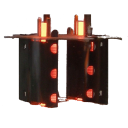Some resources I found particularly serious:
The Valve Wizard/ is maintained by someone highly knowledgeable and technically professional; you find there excellent guidelines to bias a stage, to design your power supply, and a unique and must-have guide to correctly route and ground an amp, something critical for minimising hum and noises; additionaly, its sells cleverly designed PCBs and a full book “Designing Tube Preamps for Guitar and Bass”: I purchased it (Jan 2020) after the excellent comments on the web and I confirm it is a must for anyone interested in designing with tubes!
Lenard Audio Institute A very well documented place, covering topics far beyond tubes, and written by someone who does not mince words… Many concepts and advices sustained by a sufficient theoretical background; this site is very complete about sound topics.
Hosenlander triode common-cathode amplifier calculator provides an elaborated DC and AC calculator for triode gain stage. Only the ECC83 is modelised, but it covers all important aspects to simulate and design a gain stage.
Elliott Sound Products is actually a large book about the art of designing amplifier, be they with valves (tubes) or semiconductors. The author has accumulated an astonishing amount of practice and experiments.
Norman Koren Vacuum tube audio pages the father of the mathematical model used by my solvers.
Duncans’ Amp Pages a lot of stuff, including Spice models.
Universal loadline calculator for vacuum tubes is a quite useful tool for power as well as for small signal tubes.
Triode / Pentode Loadline Simulator is another tool for computing and displaying loadline for a wide choice of tubes.
Tube CAD Journal many technical posts and articles related to tubes and audio. I discovered this site by fall 2022 and the many clever circuits described provide matter for devising new solvers for the DCTriode freeware.
And last but not least, The Valve Museum provides a lot of information on the world and history of vacuum tubes. The icon for the DCTriode PC app was obtained by courtesy of Allan Wyatt of The Valve Museum.
